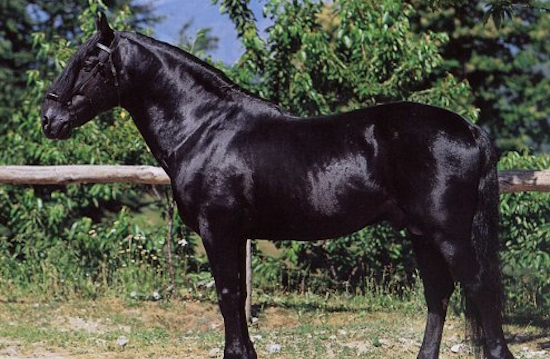Murgese horse
Puglia boasts its own horse breed, the Murgese, certainly one of the most prized and uncontaminated in ancient times. The breeding area of the Murgese horse is identified with a specific area of the Murge, including the territories and woodland pastures of the municipalities of Alberobello, Ceglie Messapico, Cisternino, Martina Franca, Locorotondo and Noci, with an ancient breeding tradition.
The origins of the Murgese horse date back to the era of Spanish domination. It is said that oriental, African and even Arabian stallions, imported by the Count of Conversano for the improvement of his herd, contributed to the formation of this breed.
The selection work for the Murgese breed was started in 1926 on the initiative of the "Stallion Deposit" of Foggia, later transformed into the Institute of Horse Riding for Puglia which established the first selected horse stations in the Murge area. Finally, with the Decree of the Ministry of Agricultural, Food and Forestry Policies of 8 October 2008, the herd book of the Murgese Horse breed was established at the Italian Breeders' Association of Rome.
From a horse population still heterogeneous in terms of some morphological characteristics, we have arrived, through a long and careful selection process, at the current type, well-defined, with the following characteristics:
• coat preferably jet black, iron gray and dark brown also permitted; no particular signs;
• slightly monotonous flat profile head, wide forehead with large tuft;
• neck with wide attachment base and abundant mane;
• well-developed chest;
•regular lumbar back line, sometimes more depressed;
• solid limbs, with a medium long and wide forearm, leg of correct length and inclination, short shins and tethers with regular and solid hooves.
Of lively temperament and mesomorphic type, of extraordinary physical prowess, with aptitude for agricultural work, and medium-light shooting, it is commendably used on farm holidays for its excellent rustic qualities, for country riding and for attacks.
It is bred wild in a particularly difficult, extremely suggestive and picturesque environment made up of bushy pastures, oak woods, mixed forests of the mid-hills, and areas with a low rainfall rate, which are difficult for other species of zootechnical interest to exploit. Only in critical periods, the pasture is integrated with oats and broad bean and barley flours.
This breeding system enhances the peculiar characteristics of this breed and its qualities of frugality; so that, hardened in a similar environment, it has all the requirements to spread in hilly and mountain areas without fear of failure. It is well known to the breeders of the Murge that the most typical and successful production is obtained from mares bred in the wild in the woods.
